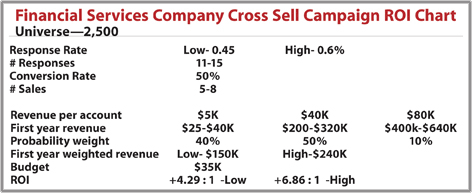Justification is the name of the game when it comes to determining a direct marketing budget. It’s no longer good enough to make generalizations about how much revenue you’ll make or what the margin contribution to your bottom line will be. Today, management wants to know what the ROI is going to be before releasing funds. And they want to see detailed proforma metrics as the justification, regardless of the size of the program.
When kicking off a DM campaign or program we often start with the question: “How do you define success?” The answers vary from “better response rates” to “increased awareness” to “increased sales.” We often respond with another question that speaks to the amount of budget available to support the program. Sometimes the budget is defined, sometimes not. And then the real question becomes one of determining the appropriate budget that can deliver the success criteria in question, and to do so with an acceptable ROI.
ROI is the End-Game
ROI has become the yardstick that business uses to judge performance. To be effective as an analytical tool, however, the data that goes into the calculation must be reliable.
In particular, response and/or conversion data sometimes is either not available or suspect and yet an ROI needs to be estimated in order to persuade management to release funding. Perhaps there is no response history because the product or service is new, or marketing conditions have changed which will have an effect on future response rates, or the response history is questionable because of incomplete or inaccurate data. Regardless of the reason, response and/or conversion rates need to be developed so that a realistic revenue estimate can be established and then compared back to costs associated with the program.
Weighted Averages Can Bridge the Gap
One answer that works reasonably well if one doesn’t have enough reliable data is creating a range of data points (high, middle, low) and apply a weighted average using criteria that either ties back to:
- Industry norms
- Earlier campaigns for similar products or services
- Previous tests done on the product or service in question
This process of establishing a weighted average can also be applied to the revenue side of the ROI ratio. For example, the chart below recaps an ROI calculation using weighted averages for a financial services company offering insurance products to businesses. In this example it knows that smaller accounts (those with less than 50 employees) are each worth $5,000 annually. Middle markets accounts (51-150 employees) are worth $40,000 and large accounts (151+ employees) are each worth $80,000 each. Let’s assume this is a cross sell program where we will target all existing customers. We’ve decided that the expected response rate will be between 0.45% and 0.60% for the DM effort and the expected conversion rate will be 50%. Assuming a universe of 2,500 customers we will generate between 5-8 new sales. Using the revenue amounts previously discussed we then calculate a total year 1 revenue range that ties back to the high and low response rate range for each account grouping. Once this revenue range is established we assign probability weights to each group of accounts and calculate the total expected revenue estimate that ties back to the initial response rate range. These weight averaged revenue estimates are then divided into the budget to create the ROI ratios.

Working with a Pre-Determined ROI
Many times a client will start the process with a pre-determined budget and a sales goal. Thus, the ROI has already been set and what’s left is developing the strategy to achieve both sides of the ratio. We, as DM practitioners, sometimes feel trapped because either the budget or the sales goal is unrealistic in light of expected response and/or conversion rates. In many cases, however, the client is justified in challenging us to work with limited dollars and/or aggressive sales goals because the client must map the program’s ROI back into their overall business model.
The problem some DM practitioners fall into is allowing unrealistic response and/or conversion metrics to be used to make the ratio work. Sometimes a “break through” idea will emerge that boosts results in a dramatic way. But that is usually the exception, not the rule. The more likely scenario is that actual response/conversion metrics fall short and the program is judged a failure when, in fact, the program was doomed from the start because of an unrealistic ROI.
One way to avoid this trap is for the DM practitioner to build a case for using a longer time horizon that will show where the breakeven point is between revenue and cost. At least everyone can see how long it will take before a customer becomes profitable. An extension to this is looking at the lifetime value of the customer and calculating the ROI against that timeframe.
A Final Word of Caution
It’s easy to take comfort in calculating ROI on a proforma basis. But in reality a pro forma ROI is only an indicator of how successful a program will be. It is not a guarantee. As DM practitioners it is our job to point out any limitations that will affect their reliability. Just presenting the numbers without discussion/rationale is dangerous at best. Clients need understand the relative importance that should be placed on a given metric so that expectations can be managed from the outset.
Bruce Wagoner is managing director or Wilde Direct, a Holliston, MA-based direct marketing agency.



